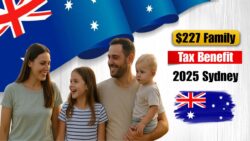Tax-Free Savings and Pension Plans 2025 – Canada’s financial landscape in 2025 has brought good news for savers and retirees. With the updated CRA guidelines, Canadians can now benefit from enhanced Tax-Free Savings and Pension Plans that allow them to save up to $6,500 without paying any tax on the gains. This move is part of a broader strategy by the government to help individuals build secure financial futures while reducing taxable income. Whether you’re planning retirement or just beginning to save, these changes offer a valuable opportunity to grow your money more efficiently. In this article, we break down what’s new, who qualifies, and how to make the most of these tax-free benefits in 2025.

Tax-Free Savings Account (TFSA) 2025 Contribution Limit
The Canada Revenue Agency (CRA) has officially confirmed that the Tax-Free Savings Account (TFSA) contribution limit for 2025 is $6,500. This means eligible Canadians can invest this amount in a TFSA and earn interest, dividends, or capital gains—completely tax-free. The TFSA is an ideal tool for short- and long-term savings goals because there are no penalties or taxes when withdrawing funds. Unlike RRSPs, TFSA withdrawals do not impact government benefits such as GIS or OAS. It’s crucial to ensure you stay within your annual and lifetime contribution limits to avoid penalties. For those who haven’t contributed in earlier years, unused room carries forward, offering even greater savings potential in 2025.
Registered Retirement Savings Plan (RRSP) Benefits for 2025
Alongside TFSAs, the Registered Retirement Savings Plan (RRSP) remains a cornerstone of retirement planning in Canada. In 2025, Canadians can contribute up to 18% of their earned income, up to the RRSP maximum set by CRA (which is $31,560 for the year). RRSP contributions are tax-deductible, reducing your taxable income and resulting in potential tax refunds. Funds grow tax-deferred, meaning you won’t pay taxes until withdrawal—usually during retirement when you may be in a lower tax bracket. RRSPs are particularly valuable for high-income earners aiming to lower their tax liabilities while securing future income. Combining RRSP with TFSA strategies offers a well-rounded financial plan.
| Plan Type | 2025 Limit | Tax Benefit | Best For | Withdrawal Rules |
|---|---|---|---|---|
| TFSA | $6,500 | Tax-Free Growth | All Income Levels | Tax-Free Anytime |
| RRSP | $31,560 | Tax Deduction | High Earners | Taxed at Withdrawal |
| FHSA | $8,000 | Tax-Free Home Saving | First-Time Buyers | Tax-Free for Homes |
| RESP | No Limit (Grant Capped) | Tax-Deferred + Grants | Parents & Guardians | Taxed in Child’s Name |
| RDSP | Varies | Grants + Bonds | Disabled Individuals | Tax-Deferred |
Maximize Your CRA Tax-Free Savings Options
To take full advantage of the 2025 CRA guidelines, it’s essential to strategically plan your savings using a combination of TFSA and RRSP. While TFSA offers unmatched flexibility, RRSP provides immediate tax relief. Young earners or low-income individuals may benefit more from using TFSA first, while those in higher tax brackets should prioritize RRSPs. You can also explore newer plans like the First Home Savings Account (FHSA) for property goals or the Registered Disability Savings Plan (RDSP) if eligible. Automating contributions and reviewing your room annually can help ensure you’re not missing out. With proper planning, Canadians can create a powerful, tax-efficient savings portfolio this year.
CRA Savings Programs Explained Clearly
The CRA offers several savings and pension programs, each designed for different life stages and goals. While TFSA suits general savings and emergency funds, RRSPs are tailor-made for retirement. For young families, RESP helps fund children’s education with grants from the government. Meanwhile, FHSA assists first-time homebuyers, and RDSP provides security for Canadians with disabilities. These plans come with specific rules, contribution caps, and withdrawal terms, making it important to understand each program before contributing. By mixing and matching based on your income, age, and financial targets, you can make the most of what CRA has to offer in 2025 without paying extra tax.
Frequently Asked Questions (FAQs)
1. What is the TFSA limit for 2025?
The TFSA limit for 2025 is $6,500 as announced by CRA.
2. Can I contribute to both RRSP and TFSA?
Yes, you can contribute to both as long as you stay within individual limits.
3. Are RRSP withdrawals taxable?
Yes, RRSP withdrawals are taxed as income in the year you withdraw.
4. What happens if I over-contribute to TFSA?
You’ll face a 1% penalty per month on the excess amount until corrected.




